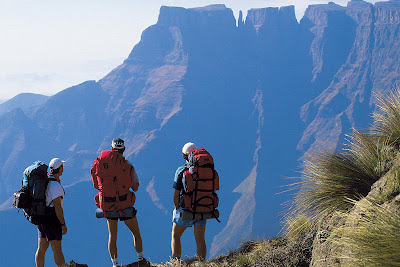The Drakensberg (Afrikaans: Drakensberge, Dutch: Drakensbergen, "the Dragon Mountains") is the highest mountain range in Southern Africa, rising to 3,482 metres (11,424 ft) in height. In Zulu, it is referred to as uKhahlamba ("barrier of spears"), and in Sesotho as Maluti (also spelled Maloti). Its geological history lends it a distinctive character amongst the mountain ranges of the world. Geologically, the range resembles the Simien Mountains of Ethiopia.
The highest peak is Thabana Ntlenyana, at 3,482 metres (11,424 ft). Other notable peaks include Mafadi at 3,450 m, Makoaneng at 3,416 m, Njesuthi at 3,408 m, Champagne Castle at 3,377 m, Giant's Castle at 3,315 m, and Ben Macdhui at 3,001 m, all of these are in the area bordering on Lesotho. Another popular area for hikers is Cathedral Peak. North of Lesotho the range becomes lower and less rugged until entering Mpumalanga where the quartzite mountains of the Transvaal Drakensberg are loftier and more broken and form the eastern rim of the Transvaal Basin, the Blyde River Canyon lying within this stretch. The geology of this section is the same as and continuous with that of the Magaliesberg.
Other peaks include:
The high treeless peaks of the Drakensberg (from 2,500 m upwards) have been described by the World Wildlife Fund as the Drakensberg alti-montane grasslands and woodlands ecoregion. These steep slopes are the most southerly high mountains in Africa, and being further from the equator provide cooler habitats at lower elevations than most mountain ranges on the continent. The high rainfall generates many mountain streams and rivers, including the sources of the Orange River, southern Africa's longest, and the Tugela River. These mountains also have the world's second-highest waterfall, the Tugela Falls (Thukela Falls), which has a total drop of 947 metres. The rivers that run from the Drakensberg are an essential resource for South Africa's economy, providing water for the industrial provinces of Mpumalanga and Gauteng, which contains the city of Johannesburg.[4] The climate is wet and cool at the high altitudes, which experience snowfall in winter.
Meanwhile the grassy lower slopes (from 1,800 to 2,500 m) of the Drakensberg in Swaziland, South Africa and Lesotho constitute the Drakensberg Montane Grassland, Woodland, and Forest.






0 Comment:
Post a Comment